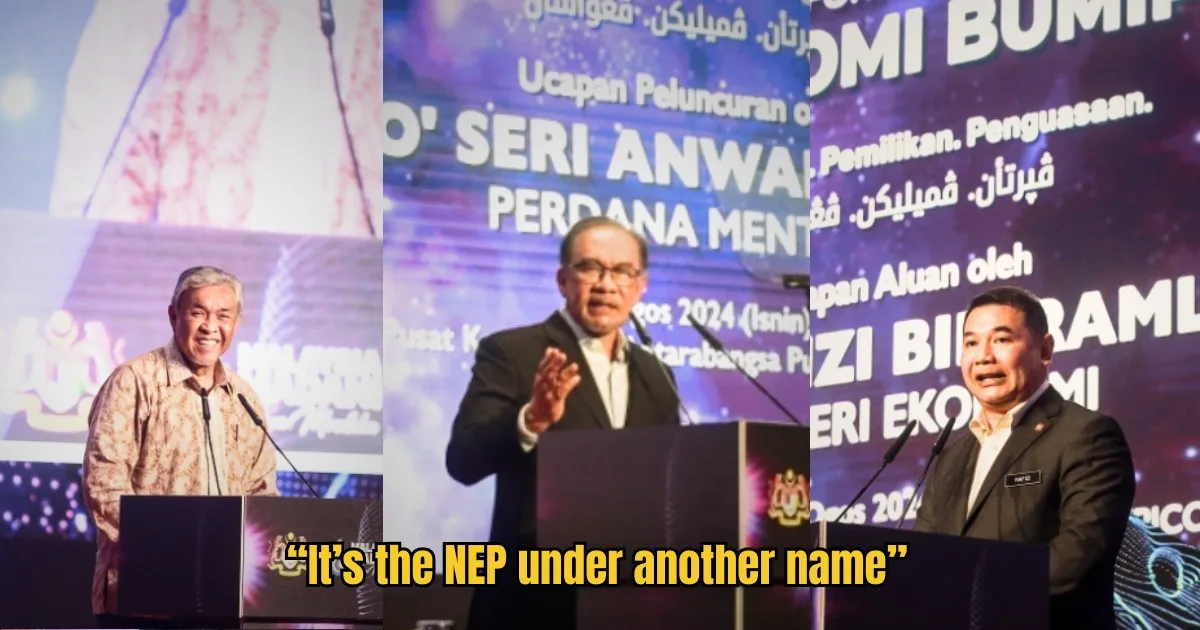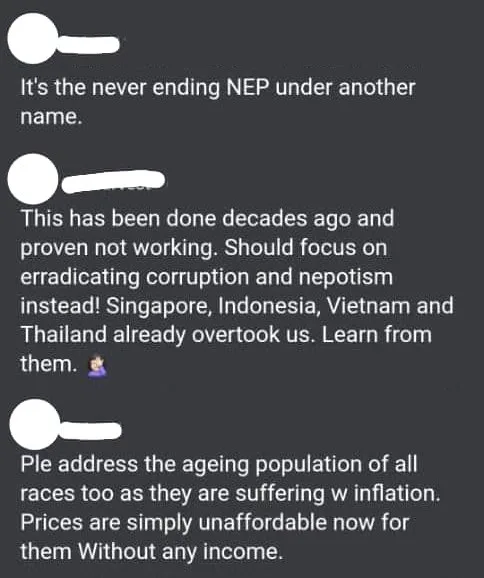Disclaimer: In Real Life is a platform for everyday people to share their experiences and voices. All articles are personal stories and do not necessarily echo In Real Life’s sentiments.

Anwar has just announced PuTERA35, and Malaysians are already comparing it unfavourably to the divisive NEP. Here’s what they’re saying:
The PuTERA35 initiative was recently launched by the Anwar administration on Aug 19th, and the ambitious 11-year plan aims to address the economic disparity between the Bumiputera community and the non-Bumiputera population in Malaysia.
Officially known as the Bumiputera Economic Transformation Plan 2035, PM Datuk Seri Anwar Ibrahim has promised that the plan will emphasise inclusivity, stressing that while the focus is on uplifting the Bumiputera, the non-Bumiputera community will not be deprived of their rights.
Here is a breakdown of the plan:
Goals:
- Economic Participation: Increase Bumiputera employment in skilled sectors to 70% by 2035, from 61% in 2022.
- Ownership and Control: Raise Bumiputera ownership in business shares from 18.4% in 2020 to 30% by 2035, with a focus on involvement in government-linked companies (GLCs) and investment companies (GLICs).
- Social Justice and Regional Development: Eliminate extreme poverty among Bumiputera and reduce income disparity between ethnic groups, particularly in underdeveloped regions like Sabah, Sarawak, and among the Orang Asli.
Key Strategies:
- Strengthening the Economy: Enhance competitiveness, talent development, and wealth creation for the Bumiputera community, supported by strict monitoring.
- Improving Governance: Involve private sectors, GLCs, and government institutions to uphold Bumiputera philosophies and refine governance practices.
- Promoting Social Justice: Focus on eradicating poverty, increasing Bumiputera home ownership, and boosting their contribution to GDP.
Inclusive Approach: PuTERA35 emphasises cooperation across ethnic lines, ensuring that non-Bumiputera communities are not deprived of their rights and that all ethnic groups benefit from economic growth, according to Anwar.
Monitoring and Oversight: The Bumiputera Agenda Empowerment Unit will track the progress of PuTERA35, alongside other government agencies such as the Bumiputera Economic Council chaired by Prime Minister Anwar, the Bumiputera Economic Council Working Committee led by Economy Minister Rafizi Ramli, and the Bumiputera Economic Council Steering Committee chaired by Deputy Prime Minister Datuk Seri Ahmad Zahid Hamidi.
You can read a full explanation of the PuTERA35 policy in this report.
Malaysians reacted with critical remarks
Reacting to the news, Malaysians chimed in with their opinions and criticising the plan. Some compared it unfavourably to the New Economic Policy (NEP), which was implemented in 1971 and has been ongoing till today.
“It’s the neverending NEP under another name,” said one commenter.
Another said, “This has been done decades ago and proven not working. Should focus on eradicating corruption and nepotism instead! Singapore, Indonesia, Vietnam and Thailand have already overtook us. Learn from them.”
Many Malaysians pointed out the unfairness of focusing on Bumiputera economic growth, bringing up how the cost of living is becoming unaffordable for all Malaysians, not just Bumiputera.
One more commenter said, “Please address the ageing population of all races in Malaysia as they are suffering from (the effects of) inflation.”

Source: MalayMail
While it is understandable that Malaysians, especially the non-Bumiputera, are aggrieved by the selective nature of the Bumiputera-first policies, the question remains: Did the NEP succeed in bringing the Bumiputeras to economic prosperity?
And if the NEP was a failure, how will PuTERA35 be implemented more fairly?
Impact of the NEP Over the Last Three Decades
The NEP (New Economic Policy) was introduced in 1971 following the racial riots of May 13, 1969. Its primary objective was to reduce the economic gap between the Bumiputera (the majority Malay and indigenous population) and the non-Bumiputera (primarily Chinese and Indian Malaysians). This involved increasing Bumiputera participation in the economy through quotas in education, business ownership, and employment.
Over the last three decades, the NEP has had mixed results. On the positive side, it significantly increased the number of Bumiputera in the middle class, improved their access to education, and allowed for greater Bumiputera participation in the corporate sector.
However, the NEP has also been criticised for creating a crony capitalist system that disproportionately benefited a small elite within the Bumiputera community.
Instead of broad-based wealth distribution, many of the economic gains were concentrated in the hands of politically connected individuals and businesses. This led to inefficiencies in the economy, where certain sectors became reliant on government handouts and lacked competitiveness.
The NEP also inadvertently fostered resentment among the non-Bumiputera, who felt marginalised by policies favouring the Bumiputera majority.
PuTERA35: A Modern Approach
In contrast to the NEP, PuTERA35 claims to take a more measured and inclusive approach according to PM Anwar. While it retains the focus on uplifting the Bumiputera, it explicitly aims to do so “without depriving the non-Bumiputera of their rights.”
The initiative emphasises cross-ethnic cooperation, suggesting a shift from the NEP’s more rigid, race-based policies to a framework that seeks to elevate the economic standing of the Bumiputera through broader national growth.
PuTERA35 also places a stronger emphasis on measurable outcomes, with nearly 100 action areas being monitored by the Bumiputera Agenda Empowerment Unit. This focus on metrics and accountability is a departure from the NEP, which was often criticised for its lack of transparency and oversight.
However, there are risks that PuTERA35 could fall into the same traps as the NEP. The initiative could become another vehicle for cronyism and the misallocation of resources. For PuTERA35 to be effective, it must be implemented with strict oversight, transparency, and a commitment to genuine economic empowerment rather than just meeting quotas.
At the end of the day, effective use of taxpayer money, whether through PuTERA35 or alternative programs, is the key to ensuring that the broader Malaysian population benefits from national development efforts.
What do you think of the new PuTERA35 initiative?
Write in to ym.efillaerni@olleh with your opinions and you may be featured on In Real Life Malaysia.
Read also: Malaysia’s National Average Wage Can’t Deal With Inflation In 2024
Malaysia’s National Average Wage Can’t Deal With Inflation In 2024
More from Viral News
“I Miss My Home,” Shares M’sian Cosplayer Who Lost Everything in Putra Heights Explosion
This story is about Elizabeth Mae Hendroff, a Malaysian content creator and cosplayer whose life was turned upside down by …
“The Windows Were Shaking” Victims of the Putra Heights Gas Fire Share Their Firsthand Experiences
Residents of Putra Heights recall their narrow escape from a 30-meter high inferno that erupted from a gas leak in …
“RM15 For Roti John? Even McD Cheaper Lah,” Shares M’sian Shocked By Ramadan Bazaar Prices
Every Ramadan, Malaysians look forward to the festive bazaars selling mouthwatering dishes, from ayam percik to murtabak. But this year, …
















